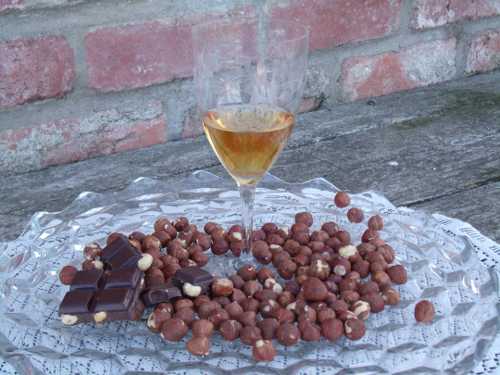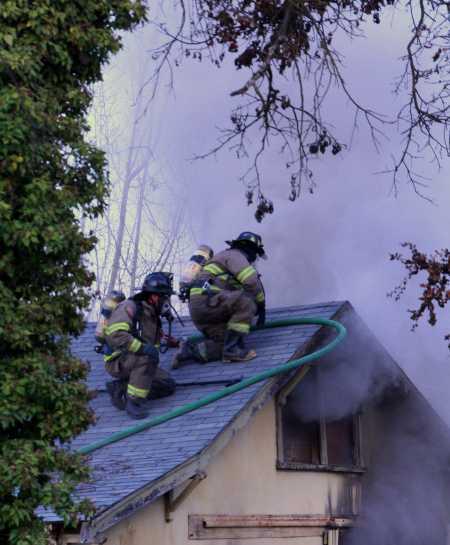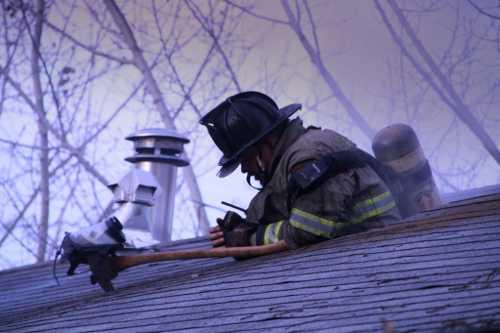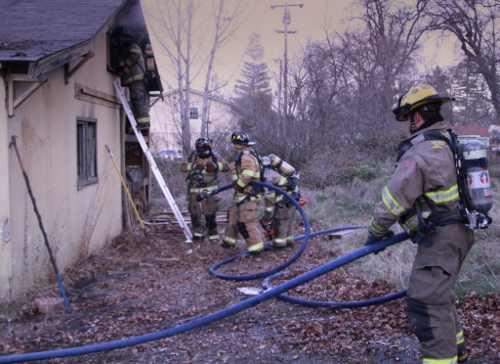
Biologists are working in the Mendocino National Forest to understand the decline of deer in the West. Photo by Derek Pell.
HIDDEN VALLEY LAKE, Calif. – It’s one of the perks of rural life; seeing animals. In the Hidden Valley Lake subdivision, deer are as much a part of the landscape as golf carts.
They glide through the oaks, doze in yards alongside cats and browse next to the security gate. Their biggest threat may be cars, and the deer seem to know it as they wait like pedestrians at crosswalks before stepping out. Last spring the fawns arrived and the suburban herd grew that much larger.
“That's how it used to be all over the county,” said California Department of Fish and Game Warden Lynette Shimek. Then comes the surprise for those who think the area is overrun by deer: “Now I get excited if I see one on a remote hillside,” she said.
According to Shimek, deer are definitely not overpopulated anywhere except subdivisions like Hidden Valley Lake. “They are there because they were born there and have lost the ability to live in the wild … generation after generation,” she said. The phenomenon of suburban wildlife occurs everywhere from urban to remote areas. As development displaces their turf, some animals adapt to these niches. Biologists say that deer are one species that can thrive in “edge” ecosystems.
The overlapping of natural and less-natural habitat is especially noticeable in Lake County, where forests abut residential developments – and some might say the deer prefer the subdivisions. But there’s a larger pattern at work, one that has sent wildlife experts into the Mendocino National Forest to hunt for answers: deer are declining.
Another ‘deer problem’
In the 1990s biologists worried about a very different "deer problem" that existed from the Rockies to New England and the Deep South.
Both rural and suburban areas were accosted by whitetail deer devouring shrubbery and crops, spreading disease and causing hundreds of thousands of auto wrecks, newspapers reported.
Back then, fast-multiplying herds were altering the ecology of forests by stripping native vegetation and eliminating niches for other wildlife.
The problem was spotty in the West. It was mainly caused by whitetails in densely suburbanized areas in the East and Midwest.
Now, if hunter harvest is the yardstick, Eastern deer are also facing challenges. The 2009-10 whitetail deer harvest was down by 11 percent in Virginia and 8 percent in Pennsylvania.
That trend has been noticed in Western deer on a dramatic scale for decades.
In California’s eastern Sierra Nevada, mule deer have reportedly declined 84 percent from 1985 to 1991.
Arizona’s mule deer herd is about half what it was in 1986, according to the Arizona Game and Fish Department.
Estimates by the Colorado Division of Wildlife show the mule deer population on the Uncompahgre Plateau also dropped by half between the early 1980s and the late 1990s, a decline biologists consider “indicative of a much larger problem related to overall ecosystem health.”
In Wyoming, where heavy energy development is under way, mule deer reached a threshold of decline last year that triggers a mitigation response, according to Game and Fish biologists, who fear that intervention like winter feeding may not halt declines.
In Oregon, Fish and Wildlife has launched a Mule Deer Initiative, and in Utah, where mule deer have been in decline for 35 years, the Utah Wildlife Board decided to issue fewer hunting permits for the 2012 season.

Deer are common in some suburban areas, like Hidden Valley Lake, Calif. But they are declining in parts of the wild. Photo by Derek Pell.
Studying the decline’s factors
Deer are definitely declining, especially in the West, “but it’s not the end of the species,” said Tavis Forrester, a University of California, Davis doctoral candidate in ecology who leads the Mendocino Black-tailed Deer Project.
Now in its third year, the study – which encompasses Mendocino, Glenn and Lake counties – is funded mainly by the California Deer Association; a hunting group that contributed more than $60,000 over the past two years, UC Davis and the California Department of Fish and Game.
The goal is to determine if the region’s population is truly declining – or just the harvest – and if so, why? The 57 percent decline of harvested bucks has occurred over the last 20 years in prime deer habitat.
Deer have cycles in their population, Forrester says – so that may play a role. Illegal poaching is a problem, he admits. But many hunters blame four-legged predators.
Hence, the multi-species study also focuses on mountain lions, which depend on deer and elk as a main food source.
Overall, the study explores habitat use and selection, predation of fawns and adult does, habitat change over time, and mountain lion kill rates.
The blacktails under study are most likely the same species that lounge in Hidden Valley yards and drive gardeners to cage tasty plants.
Forrester said the blacktail is a subspecies of mule deer and “by far the most different” of many subspecies, with unique behavioral traits.
Others, like the wedgetail, are common around Berryessa in large areas called the “interzone,” he said, where mule deer interbreed with blacktail.
Lake County had a high population of blacktail deer in the 1960s and 1970s, Forrester said.
A 1946 report on the county’s resources that used data from California’s Department of Conservation described the forest as “the best stocked deer region in California” and “a favorite with sportsmen. The Columbian black-tail dear abound in the brush as well as in the timber belt.”
Last summer, the researchers collected data and sent a proposal to the state Department of Fish and Game to extend the study.
One challenge has been the lack of good deer population estimates, Forrester said. Fish and Game has done some spotlight counts, but the main tool has been the annual harvest.
There also is a dearth of information on the mountain lion population.
The lion factor
Forrester said one concern that prompted the study is a possible increase in their numbers.
No statewide survey has been done and it’s difficult to do research due to the cat’s status as a protected species in California. Mountain lion research may be halted altogether, he said.
Even if the population is growing and causing deer numbers to plummet, the Department of Fish and Game can’t manage them, and they can’t be hunted.
According to a progress report on the study, lions are captured “through various methods, including the use of hounds and live traps.”
Once captured and tranquilized, the lion’s health and age is assessed. Then they are equipped with a satellite GPS collar so their movements can be tracked. It takes hours in the field to even detect signs of the elusive animals.
Aside from hunters bagging fewer bucks, is there any evidence that the area’s mountain lion population is growing?
The Department of Fish and Game has arrived at what it calls a “guesstimate” of the state population of 4,000 to 6,000 mountain lions.
According to the agency’s Web site, the population “peaked in 1996, then decreased somewhat, and has remained stable for the past several years.”
So far, the study can’t determine if mountain lions are impacting the Mendocino-area blacktail population, Forrester said.
According to Marilyn Jasper of the Sierra Club’s Mother Lode chapter, predators may impact the deer population, “but the decline may mean the herd is approaching sustainable size for its habitat.”
Jasper points out that “mountain lions are beneficial to all their prey, since they normally kill the weakest or the sickest.”
Hunters, on the other hand, “kill the best – trophy – of a species, thereby upsetting the natural balance” by allowing weaker animals to survive, Jasper said.
One predator that is “definitely not affecting the deer population,” Forrester said, is the coyote, which sometimes preys on deer.
Hidden Valley Lake residents occasionally report seeing predators, such as bobcats, which Forrester said do not typically prey on deer.
While mountain lions, which have a “huge home range,” might make forays into the subdivision, Forrester doubts they have a steady presence, despite the many deer – because of the human presence.
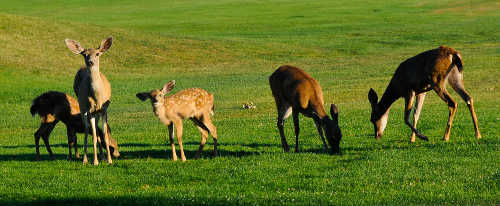
A small herd of deer graze in Hidden Valley Lake, Calif. Photo by Derek Pell.
The role of habitat loss
In Nevada, another state where mule deer are vanishing, state biologists say the problem isn’t predators: It’s the continuing loss of habitat from development, wildfire and invading non-native grasses.
Since settlement 150 years ago, many things, including livestock grazing, habitat fragmentation from gas, oil and mineral exploration and climate change, have altered the landscape, according to the Western Association of Fish and Wildlife Agencies’ Mule Deer Working Group.
Forrester cited two big changes here that have affected deer and other animals.
In the 1980s and 1990s, there was a lot of logging. Aside from destroying habitat, logging also encouraged fire suppression. American Indians intentionally set grass fires to clear old growth, Forrester said, and the oak woodlands flourished, creating fresh food sources like acorns.
When logging took over, intentional burning stopped. A thick, soil-killing, intermediate growth sprung from the clearcut void. It failed to meet the deer’s specific nutritional needs, according to Forrester.
One of the worst impacts on deer habitat has been the takeover by non-native vegetation, Forrester said.
Native perennial grasses have “totally switched over to annual grass,” Forrester said. Now in the fall, where there was once a blanket of green, everything is dead.
Subdivision-deer, however, find plenty to eat as they move through their home range, which is about one kilometer wide, seeking the most nutritious foods.
Feeding wild deer can harm them, Forrester said, as they can’t digest foods like alfalfa or bread.
Deer are highly selective feeders. They don’t graze, but pluck small flowering plants in the grass. And as gardeners know, they choose the best leaves.
In spring and summer, they prefer forbs and shrubs. Fall is the season for munching acorns. In winter, they dine on the leaves of shrubs.
Blacktails form family groups, rather than herds, Forrester said.
At this time of year, the deer cluster together in what are mostly mother-daughter groups.
In their first year, fawns stay with the mother. When the next baby is born, the mother kicks them off. The yearlings then return to the area where they were born.
As residents of Lake County subdivisions know, that might be their own backyard.
Sheila Pell is a freelance correspondent for Lake County News. She lives in Hidden Valley Lake, Calif.
Follow Lake County News on Twitter at http://twitter.com/LakeCoNews, on Tumblr at www.lakeconews.tumblr.com, on Google+, on Facebook at www.facebook.com/pages/Lake-County-News/143156775604?ref=mf and on YouTube at www.youtube.com/user/LakeCoNews .

 How to resolve AdBlock issue?
How to resolve AdBlock issue? 

